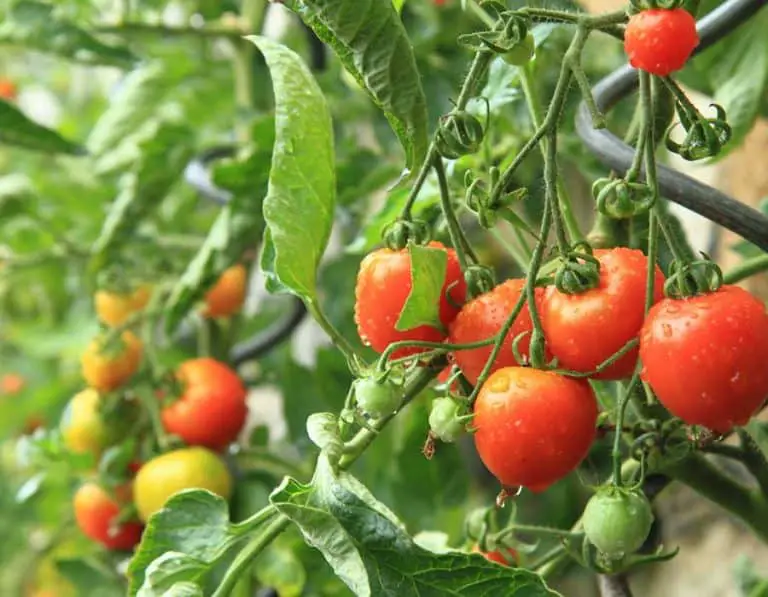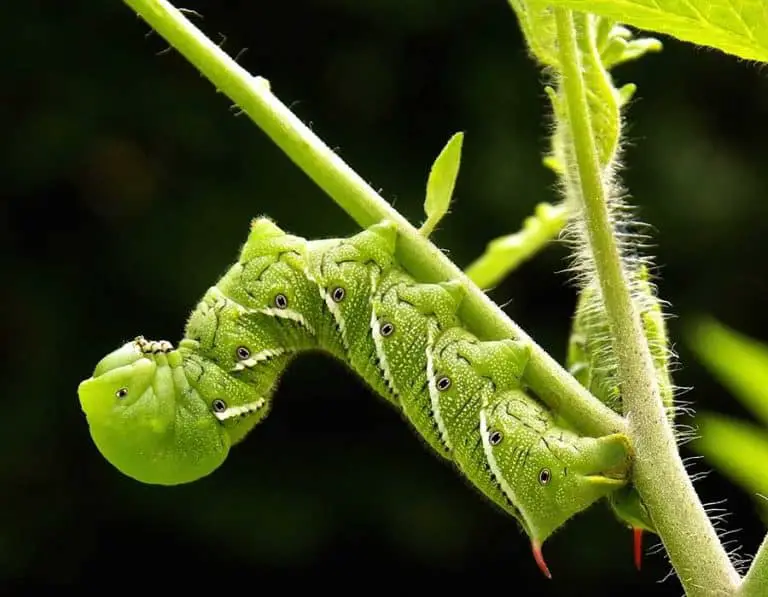Eggplant Pests and Diseases that Can Kill Your Harvest
Along with peppers, potatoes, and tomatoes, eggplants are members of the nightshade plant family. There are many types of both pests and diseases that affect vegetables like eggplant; if your eggplant crops are suffering, it’s important to diagnose what issue you’re facing to be able to cure it properly.
Some of the most common eggplant pests include aphids, colorado potato beetles, cutworms, eggplant lace bugs, flea beetles, hornworms, leafhoppers, stinkbugs, and spider mites. Common eggplant diseases include alternaria rot, blossom end rot, blight, and powdery mildew, to name a few.
Common Species of Eggplant Pests
Several species of pests favor eggplant crops, including aphids, beetles, worms, leafhoppers, and stink bugs.
1. Aphids
Aphids are tiny insects that cling to the bottom of leaves and the stems of eggplant crops. Depending on the coloring of the host plant, aphids vary between shades of green and yellow to pink and brown. The most common types of aphids that infest eggplants are the green peach aphid (Myzus persicae) and the cotton aphid (Aphis gossypii). Green peach aphids can be yellow or green, while cotton aphids may also come in shades of near-black.
Small populations of aphids rarely affect eggplant crops. However, a severe infestation of aphids will cause the leaves of the plant to turn yellow before they develop necrotic lesions. Aphids also encourage the development and spread of other diseases such as sooty mold.
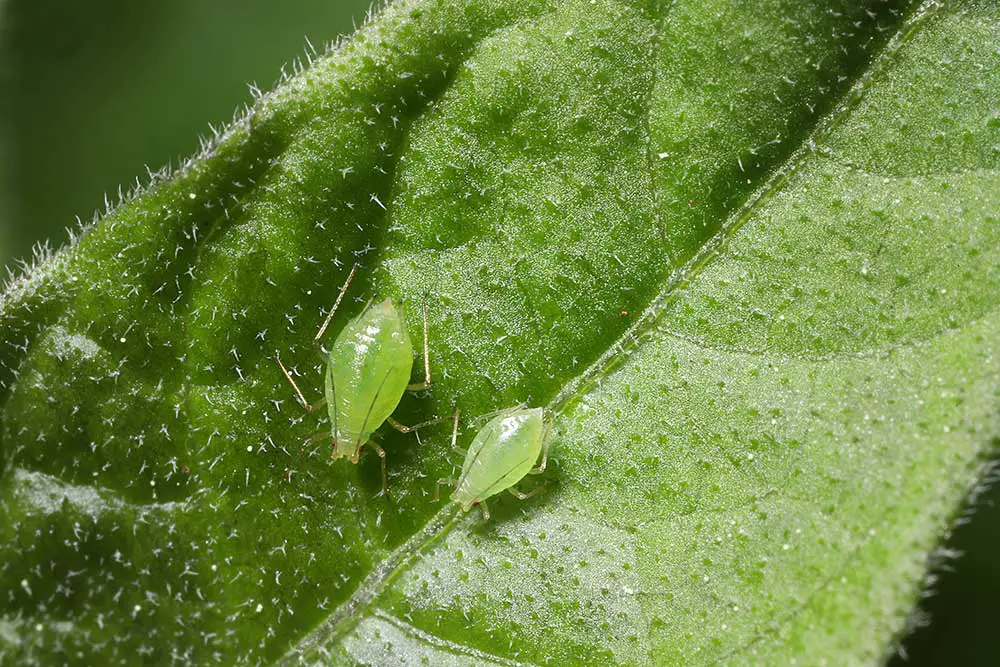
2. Colorado Potato Beetle
Colorado potato beetles (Leptinotarsa decemlineata) affect not just potatoes, but all plants in the nightshade family including eggplants. They feed on the foliage of these types of plants and are able to cause extensive damage in high numbers. The most severe infestations may cause the complete defoliation of entire plants.
The control of colorado potato beetles can be a challenge as these eggplant pests have developed a high level of resistance to insecticides. One method of control is to apply Bacillus thuringiensis, a friendly bacterium that can get rid of colorado potato beetles with frequent applications.
3. Cutworms
Cutworms (Noctuidae spp.) are eggplant pests that also affect a variety of other vegetable crops. They damage young plant seedlings by chewing through the plant stems and severing them at the soil surface. These pests can be difficult to spot as they are typically most active at night.
It’s possible to get rid of cutworms, but it requires some diligence and active effort. You’ll likely need to take a multipronged approach, by both removing the larvae manually at night and spreading diatomaceous earth in the affected areas.
4. Eggplant Lace Bugs
Eggplant lace bugs (Urenthius sp.) are small, flying insects that live and feed on the underside of the plant’s leaves. They are oblong in shape and have laced wings. Lace bugs only cause substantial damage to eggplants when present in large populations.
Lace bug damage appears as misshapen patches of discoloration on the leaves of eggplant. You will be able to see these eggplant pests by carefully observing the underside of the leaves. The best method of control to combat a lace bug infestation is the application of neem oil.
5. Flea Beetles
Flea beetles are a destructive species of beetle belonging to the Chrysomelidae family that primarily feed on leaves. They initially feed on the leaves of the eggplant, creating small holes or pits that stunt the plant’s growth. Once they have ravaged the foliage, flea beetles will move on to consume the eggplant fruits too.
Young eggplant seedlings are most susceptible to the damage that this pest causes. You can protect your seedlings from flea beetles by covering them with floating row cover. If it’s too late for preventative measures, you can control flea beetle populations with insecticides containing spinosad, permethrin, or carbaryl.
6. Hornworms
Hornworms are a group of eggplant pests that can be highly destructive to your crops. The two most common subspecies that infect eggplants are tomato hornworms (Manduca quinquemaculata) and tobacco hornworms (Manduca sexta). Both types look identical, with both being huge and easily distinguishable by their appearance; they grow to be between 3 to 4 inches in length and have a horn at one end of their bodies.
Heavy infestations of hornworms will cause damage to the leaves and fruits of your eggplants. Keep an eye out for the tell-tale holes in the leaves of your eggplants to catch this pest early before a full infestation occurs.
7. Leafhoppers
Leafhoppers are small insects with slender, green bodies. Both mature and immature leafhoppers can cause damage to eggplants by feeding and breeding on the underside of the plants’ leaves. This damage appears as yellowing on the leaves, sometimes also causing the curling and wilting of the foliage.
Identifying and controlling an infestation of leafhoppers is relatively easy. You can determine if you’re dealing with a leafhopper infestation by rustling your eggplants; the leafhoppers will hop off the plant foliage when disturbed. Apply a neem solution and continue to reapply it to get rid of these eggplant pests.
8. Stink Bugs
Several species of stink bugs can cause damage to plants in the nightshade family, such as eggplants. These pests are brown or green in color, having a distinctive shield-shaped back. Stink bug damage appears initially as dark pinpricks on the eggplant fruits. Eventually, the dark pinpricks turn yellow or light green. Stink bugs also harbor harmful pathogens that can cause secondary infections and fruit decay.
You can deter stink bugs by removing weeds and debris in the planting area, thus removing places for the stink bugs to overwinter. Getting rid of a stink bug infestation is possible with insecticidal soaps, kaolin clay, and encouraging the population of their natural predators.
9. Spider Mites
Spider mites are another eggplant pest that can cause extensive damage before they are detected. They are so challenging to spot due to being microscopic in size, and also because they tend to gather on the underside of the eggplant’s leaves. When the damage becomes visible, small white spots and a thin webbing will develop on the underside of leaves. In severe cases, entire leaves may dry up and die off, eventually leading to the death of the whole plant.
To identify spider mites, place a white piece of paper under the affected leaves and give them a sharp tap. If the mites are present, you’ll the see tiny black dots of the insects moving on the paper. You can combat a small infestation by misting the underside of leaves and encouraging the presence of ladybugs and other predators. More severe infestations may require the application of a neem solution.
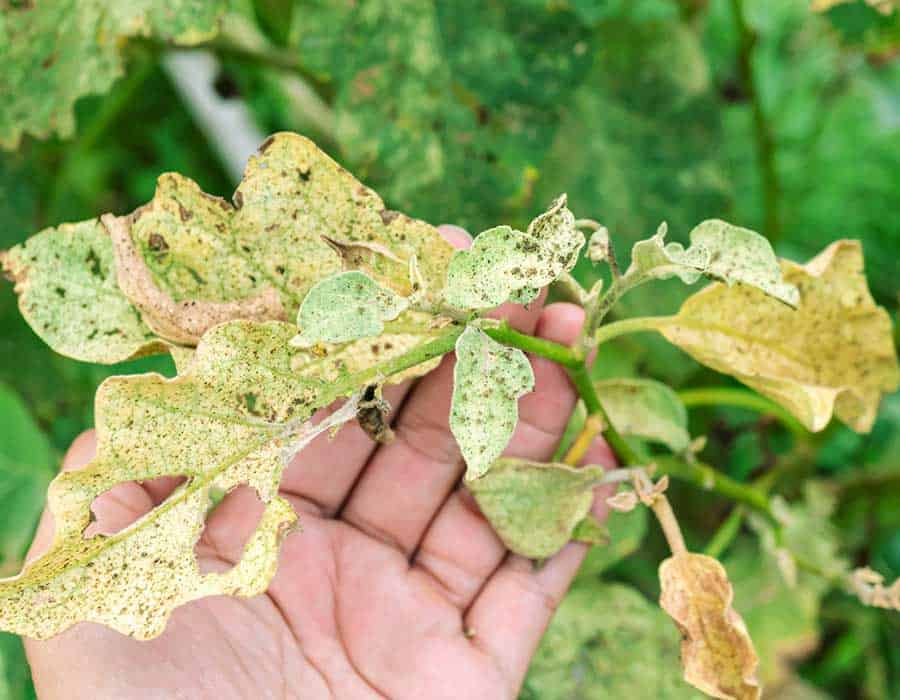
Common Eggplant Diseases
There is a number of fungal, bacterial, and physiological diseases that may affect your eggplant crops.
1. Alternaria Rot (Alternaria alternata)
Description
Alternaria rot is a fungal eggplant disease that affects both immature and mature plants.
Symptoms
Small, grey lesions will develop on eggplants suffering from Alternaria rot, developing either at the bottom of the fruit or at the site of the infestation. The lesions gradually expand in size before the disease produces patches of fuzzy spores.
Treatment
As soon as you spot Alternaria rot on your eggplants, discard all of the affected fruits immediately. After removing the bad eggplants, prevent the disease from spreading to your healthy fruits by applying an organic fungicide to the area.
2. Anthracnose Fruit Rot (Colletotrichum spp.)
Description
Anthracnose fruit rot is another fungal eggplant disease. Its alternative name, ‘ripe fruit rot’, is a reference to the fact that this disease often appears symptomless until the fruits are ripe and at the point of harvesting.
Symptoms
Anthracnose fruit rot begins with the development of small, sunken, and gooey lesions. The small spots gradually merge with each other to create larger blotches as the disease progresses. After a few days, the lesions will develop spores that appear as concentric circles of an orange or pink jelly-like substance.
Treatment
Remove and dispose of all eggplants suffering from the rot, ideally before they become overly ripe. Try to prevent the bad fruits from touching the soil surface. Replant the bed with a high-quality, disease-free seed.
3. Bacterial Wilt/Southern Wilt (Ralstonia solanacearum)
Description
Bacterial wilt is a severe bacterial eggplant disease that is also found in many other common types of plants and vegetables. This disease naturally affects tropical regions and greenhouses; however, it can infest your garden beds through plants you purchase that grew in soils contaminated with the disease. Bacterial wilt is a soil-borne disease, but it can also spread via water, plant matter, or even tools or clothes. It thrives in environments with high temperatures and high humidity.
Symptoms
At first, the disease will only cause a couple of leaves to wilt, while the rest of the eggplant’s leaves appear healthy. As the disease progresses, the rest of the leaves will wilt and turn yellow while the plant’s stem remains upright. Dark-brown splotches may form on the lower stems of the plant; when these stems are cut, they ooze a viscous, slimy substance. A milky stream of bacteria is visible from the cut if you place these stems in water.
Treatment
Unfortunately, there is no treatment or cure for bacterial wilt. Once you confirm your eggplants are suffering from this disease, you must remove all infected plants and dispose of them. Avoid placing them on your compost pile, otherwise you run the risk of reintroducing the disease when you later use the compost.
4. Blossom End Rot
Description
Blossom-end rot is a common physiological eggplant disease, as well as tomatoes, and other plants in this family. This disease typically occurs as a result of low calcium contentrations within the fruit; low calcium levels are caused when your eggplants have too much competition with other plants in the garden bed. Blossom-end rot may also be caused by fluctuations of moisture in the soil or excessive nitrogen fertilizer applications.
Symptoms
Initially, blossom-end rot appears on the ends of eggplant fruits as small, water-soaked lesions. As the disease develops, the lesions expand in size, becoming more sunken and turning black and leathery.
Treatment
To combat blossom-end rot in your eggplants, add agricultural lime to increase the amount of calcium in the soil. Test your soil regularly and maintain the pH level at 6.5. Add a layer of mulch to the planting area to reduce the stress brought on by drought. Instead of using fertilizers containing ammonium, use nitrate fertilizers, and avoid over-fertilizing.
5. Cercospora Leaf Spot (Cercospora spp.)
Description
Cercospora leaf spot is an eggplant disease caused by fungal pathogens. This fungus is hardy and can survive in your soil on crop debris overwinter before launching into action in spring.
Symptoms
The symptoms of Cercospora leaf spot develop first on the lower parts of the plant before gradually expanding upwards. This disease appears as small, circular, light to dark brown lesions. Leaves may dry out, curl, and drop off the plant in severe infestations.
Treatment
Encourage plants to dry in the day by watering in the morning and avoid leaf wetness by watering close to the base. Space your plants out sufficiently to reduce humidity in the canopy. You can also prevent and treat this disease with an appropriate fungicide.
6. Damping Off (Pythium spp., Fusarium spp.)
Description
Damping off is one of the most common eggplant diseases that primarily affects young seedlings. Pathogens in the Fusarium, Phytophthora, Pythium, and Rhizoctonia genera cause this fungal disease. It thrives in warm weather and overly wet, poorly draining soil.
Symptoms
Young eggplant seedlings either fail to emerge or emerge with light brown to red water-soaked stems and roots. Damping off may also cause the eggplants to dry up, collapse, and die.
Treatment
To avoid introducing this disease to your yard, plant disease-free seeds or transplants that orginally grew in sterilized soil. If you already have an infestation of this disease, use an appropriate fungicide to treat the area.
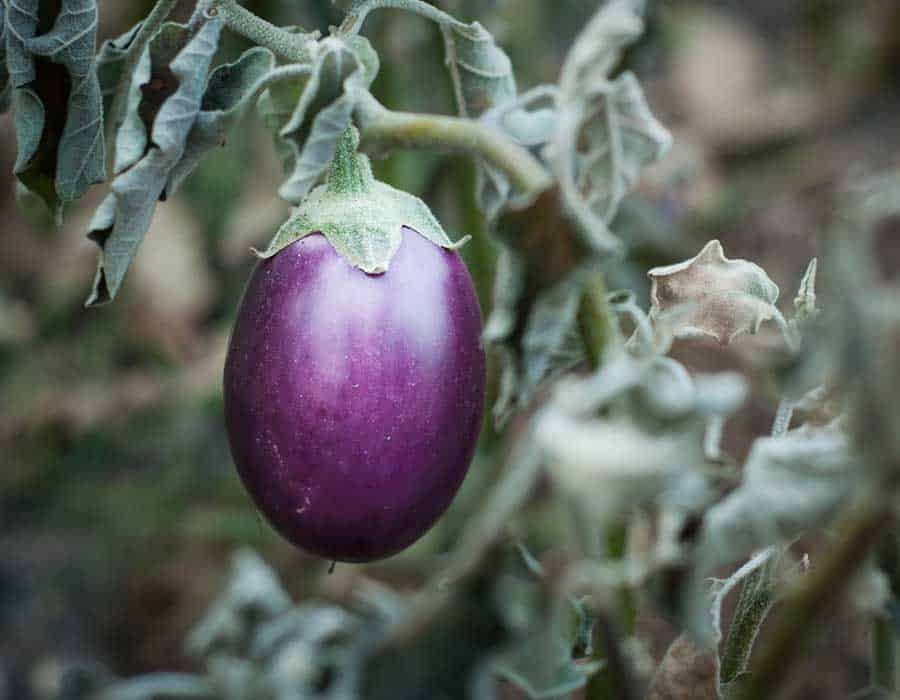
7. Early Blight (Alternaria tomatophilia)
Description
Early blight is a fungal eggplant disease. This disease typically spreads through plants rapidly after they begin fruiting.
Symptoms
The first indication of early blight is the premature dropping of the plant’s lower leaves. This disease also appears as black-brown spots or alternating rings of light and dark covering the leaf surface. Eggplant fruits may have a black velvety texture at their stem end.
Treatment
Use an appropriate fungicide to treat early blight as soon as you spot it.
8. Fusarium Wilt (Fusarium oxysporum f. sp. melongenae)
Description
Fusarium wilt is another fungal eggplant disease. It can survive in soil for many years and spreads through contaminated water, plant debris, and equipment. This disease thrives in warm temperatures and moist soil.
Symptoms
This eggplant disease typically starts out by causing the plant’s leaf petioles to droop. In its earliest stage, the disease may only cause one single branch to wilt. The wilting progresses quickly up the plant before causing it to collapse entirely. Cutting the main stem of a plant with fusarium wilt will reveal dark, lengthwise streaks. It may also cause dark-brown, sunken lesions at the plant’s base.
Treatment
To prevent fusarium wilt, try growing your crops in raised beds to encourage better drainage and remember to rotate them. You can treat infestations of fusarium using a suitable fungicide.
9. Phytophthora Blight (Phytophthora spp.)
Description
Phytophthora blight is an eggplant isease caused by oomycetes or ‘water molds’, which are organisms similar to fungi. This disease prefers overly wet soil, spreading through contaminated water and transplants.
Symptoms
Phytophthora blight causes plants to have water-soaked root systems with few secondary roots, and the roots may also have brown discoloration. Brown, water-soaked lesions may also develop on the stem at the soil surface. In severe cases, this disease kills off the eggplant entirely.
Treatment
Ensure you plant in well-draining soils and take care to avoid excessive overhead irrigation to prevent this disease from developing. Unfortunately, there is no way to cure this disease once it takes over.
10. Powdery Mildew (Erysiphe spp. and Sphaerotheca spp.)
Description
Powdery mildew is an eggplant disease caused by various types of fungi. This disease thrives in shady conditions or in areas with poor circulation.
Symptoms
It’s easy to identify powdery mildew on eggplants by its distinctive white, powdery substance covering shoots, leaves, flowers, and fruits. This disease may also cause leaves to turn yellow and wither before dropping off the plant.
Treatment
Treat powdery mildew using an organic fungicide that contains sulfur.
11. Southern Blight (Sclerotium rolfsii)
Description
Southern blight is a fungal eggplant disease that affects both seedlings and mature plants. It can survive for several years in soil and also survives over winter.
Symptoms
Eggplant seedlings with southern blight will have damping at the soil level. In mature plants, this disease appears as dark-brown lesions on stems above and just below the soil surface. The foliage turns yellow before eventually wilting. The most distinctive features of southern blight are the webs of whitish, fan-like fungal threads and small, brown masses it produces.
Treatment
To combat southern blight, maintain your soil at a pH of 7 or higher; alkaline conditions are better at inhibiting the fungi. Plowing the bed deeply is also an effective way to discourage the development of this disease.
12. Verticillium Wilt (Verticillium spp.)
Description
Verticillium wilt is another fungal eggplant disease. These fungus pathogens can survive indefinitely in soil and typically emerge in the early spring when temperatures are cool.
Symptoms
Symptoms of this disease first appear on lower leaves, before spreading up the plant rapidly. It appears as yellow blotches on leaves and causes the leaf edges to roll. In severe cases, leaves turn brown and dry up completely.
Treatment
Verticillium wilt can be very difficult to treat and control. One method is to solarize the soil; for this to be effective, you must carry it out mid-summer when you would typically grow eggplants.

